05 May 2022
![]() 20 mins Read
20 mins Read
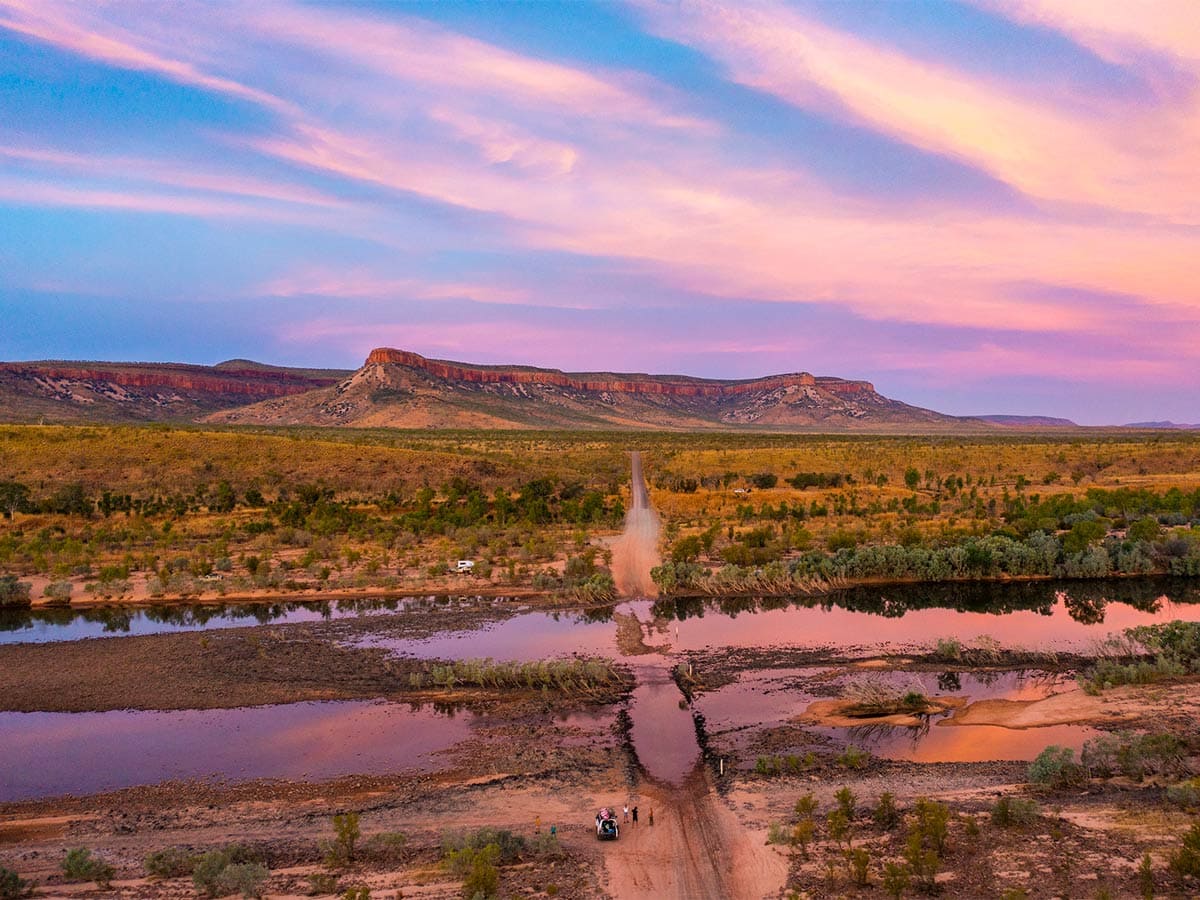
Coastal drives don’t come more remote – or rewarding – than the one from Broome to Cape Leveque in Western Australia. It’s a 206-kilometre journey taking roughly three hours without too many stops, but, trust us, you are going to want to stop for the stunning beaches and welcoming Aboriginal communities.
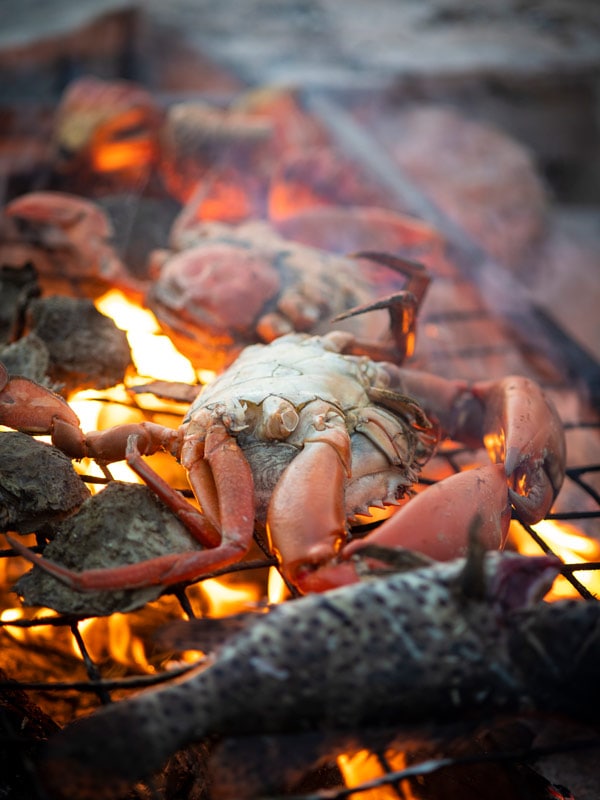
Treat yourself to a cultural tour with Bolo in Dampier Peninsula. (Image: Tourism Western Australia)
Heading north out of Broome, the Broome Cape Leveque Road charts a path through the pristine Dampier Peninsula, taking in Beagle Bay, where Sacred Heart Church, with its altar decorated with Mother of Pearl, is a delightful diversion, and Lombadina, to experience the local way of life of the Bardi people.
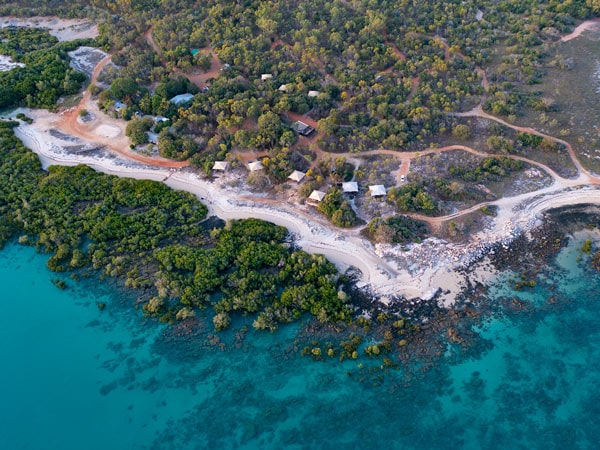
Make a visit to Cygnet Bay Pearl Farm. (Image: Tourism Western Australia)
Cape Leveque is famed as the place where the red sands of the outback melt into the startling blue/green waters of the Indian Ocean, and it really is a sight to behold. Continue on to the evocatively named One Arm Point (Ardyaloon) to finish your trip gazing out to the beauty of the Buccaneer Archipelago and camping under the inky black night skies.
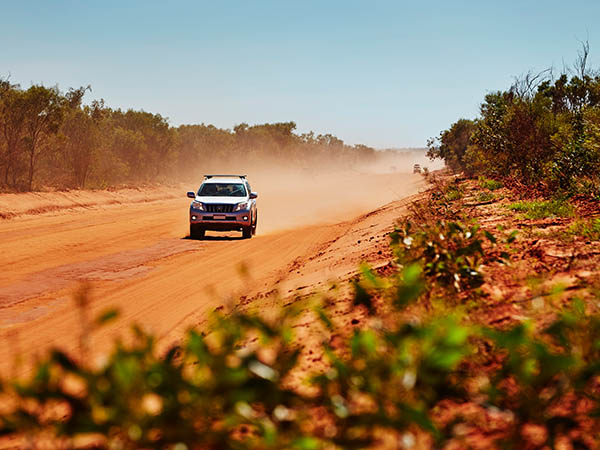
Adventure on red-soil country along the rural Cape Leveque Road (Credit: Tourism Western Australia)
Storied in outback folklore, ‘The Gibb’ is both emphatically terrestrial but entirely otherworldly. As far as journeys go, this intrepid drive quietly tattoos an everlasting ownership across your heart with its penetrating beauty and consuming remoteness. Yet it’s not for the timid of heart.
Corrugated roads rearrange the marrow of your bones, toothy reptiles lurk in dark waters, seemingly fatalistic bovines lurch into the path of your 4WD, and backpackers (overwhelmingly German and stalking profound isolation) populate campgrounds.
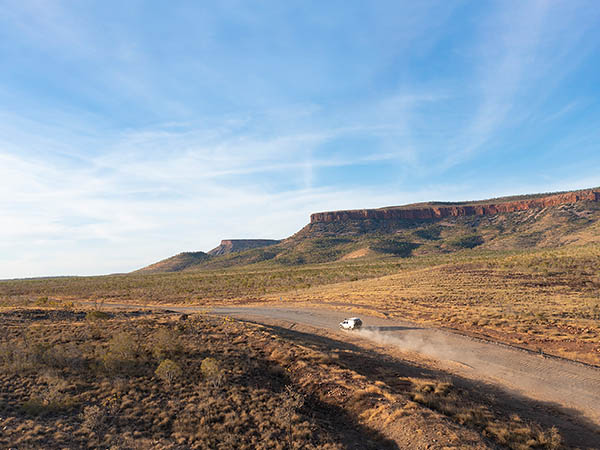
Embrace the outback along Gibb River Road. (Image: Tourism Western Australia)
The 660-kilometre road trip from Derby to Kununurra, minus detours, was laid in the 1960s as a means of shuttling cattle from station to station. But today, it’s better loved as a roughly two-week-long adventure drive that lures everyone from senior explorers to the aforementioned backpackers, and naively ambitious families.
In Australia’s North West, the first sensory bafflement comes at Broome, where most people launch their Gibb River Road exploration. Here, the contrasting collision of iridescent blue ocean and the ochre cliffs of the Kimberley resets your parameters for appropriate coastal colour palettes.
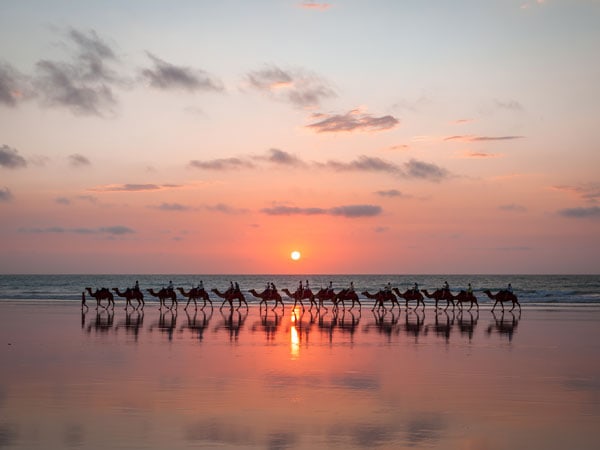
Ride a camel at sunset in Broome, WA.
But as you drive from the revitalising blue of crystalline waves, you find yourself following an endless spectrum of warm tones. Red pindan is displaced by tyres and, in turn, displaces many a tyre.
Cream-coloured dust seeps into every seam of every item. And the King Leopold Ranges bathed with the highlighter-pink of sunset are set ablaze until the deep mauves of dusk descend to cool everything down.
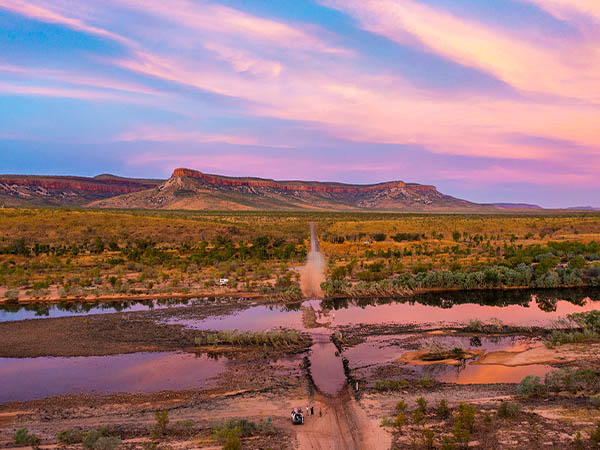
The sunset puts on a spectacle of vibrant colours each evening in the Kimberly. (Image: Tourism Western Australia)
Then, there are the night skies. They deliver a transformative surprise on your first night free from light pollution. You might just glance up as you make your way to the Windjana Gorge Campsite toilet block and – bam! – you’re anchored mid-step as the Milky Way unfurls in all its glittery loveliness above. This moment reveals a supreme awareness of your miniscule part in the universe, alongside envy for astrophysicists and their vocational stargazing.

Marvel at the glittering night sky in the Kimberly region. (Image: Tourism WA)
As you wiggle your way along, there are unmissable detours that make this journey exceptional. In the Napier Ranges, Windjana Gorge has an almost-unfathomable history as a reef system circa some 350 million years ago. Let your hand brush over the ancient limestone walls that were once home to Paleozoic fish and keep a lookout for their reptilian descendants lounging in pools. Don’t worry, they’re just freshies.
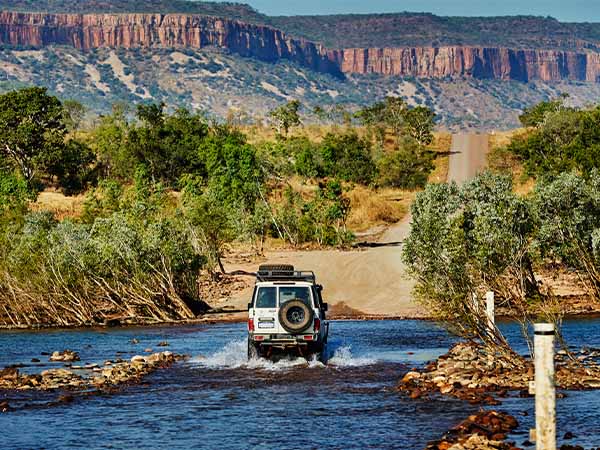
Embark on an adventurous journey into the breathtaking wilderness along the Gibb River Road. (Image: Tourism Western Australia)
Just 33 clicks up the road, enjoy the opportunity to get knee-deep in freshwater croc territory at Tunnel Creek. A locale of acute significance, this was the Waterloo of famous Indigenous leader Jandamarra, who stood his ground against exploitation but was ultimately fatally wounded here at his hideout.
These days, it’s more chillout than hideout, as lazy freshies loll in the cave’s shallow waters, watching with vague contempt as trepidatious tourists slosh by, guided through the darkness by a thin beam of torchlight.
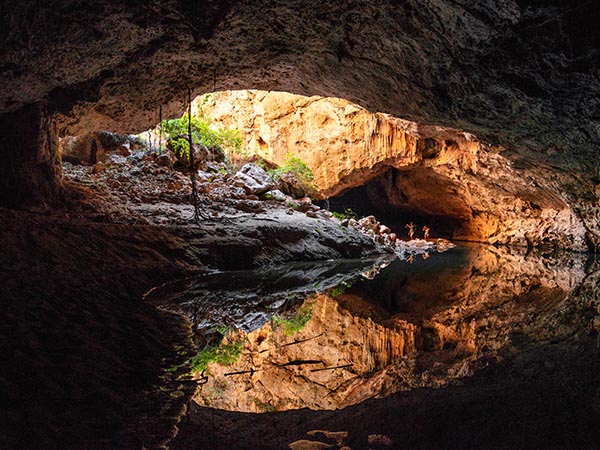
The beautiful Dimalurru (Tunnel Creek) is a culturally significant site for the local Bunuba people. (Image: Tourism Western Australia)
There are also gorges pitted with transcendent pools for plunging. Wild swimming in this way is an inimitable experience. Paddling out in surrounds as dreamily unpolished as the Australian outback has a way of storming new frontiers of relaxation.
Take your pick of gorges along, or just off, The Gibb. There’s Adcock Gorge, only five minutes off-route, which makes a quick dip irresistible.
Horseshoe-shaped Galvans Gorge is stirred by a seasonal waterfall and is accessed easily by an achievable trail.
Manning Gorge is shouldered by cooling cliffs; it takes a bit of work to hike the three-kilometre track for the pleasure of a dip, but this stunning waterhole pays big dividends for your efforts.
But Dalmanyi (or Bell Gorge) is perhaps the watery emerald in the tiara. You’ll need to allocate the heft of the day here and, at 30 kilometres from The Gibb, it’s a significant side-step. But you can spend the night at Silent Grove Campsite to make it worthwhile. Scramble over a rocky creek, then up to descend into the tiered gorge into which waterfalls cascade in silvery ribbons.
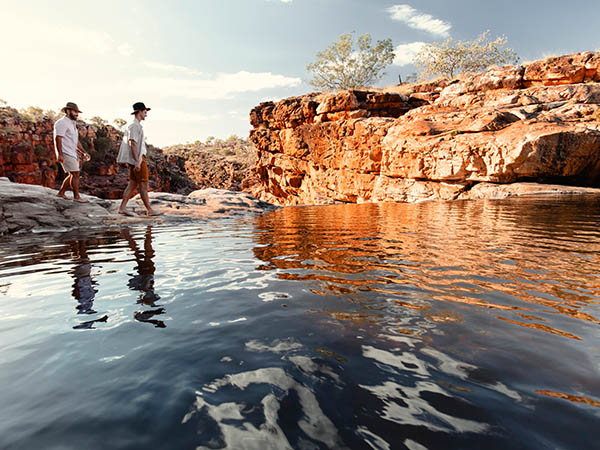
Detour for a refreshing swim at the stunning Bell Gorge (Image: Tourism WA)
Roughing it in campgrounds, such as Silent Grove, which is accessed exclusively by 4WD vehicles via a rib-rattling road, is undeniably a huge drawcard of this road trip. But you’re not letting anyone down if you leave your swag stowed for a few days in favour of a downy pillow at the El Questro Homestead.
From here you can lap up the luxury of chef-made meals, take incredible guided tours, such as fishing, cultural and scenic flights, and generally absorb the surrounding environment with a crisp glass of wine from your suite.

Take the iconic drive along Gibb River Road to El Questro.
Don’t hurry from El Questro, but when you do return to the dusty road, you’re only an hour-and-a-half from The Gibb’s full-stop of Kununurra.
Lake Argyle and the Bungle Bungle Range await to jostle for your attention. With eyes magnetised to Purnululu National Park’s banded domes, the journey hovers ethereally in the near-past.
But you’ll find, while the memory may erode a little at the edges, your wandering heart will remain sworn to this journey ever after.
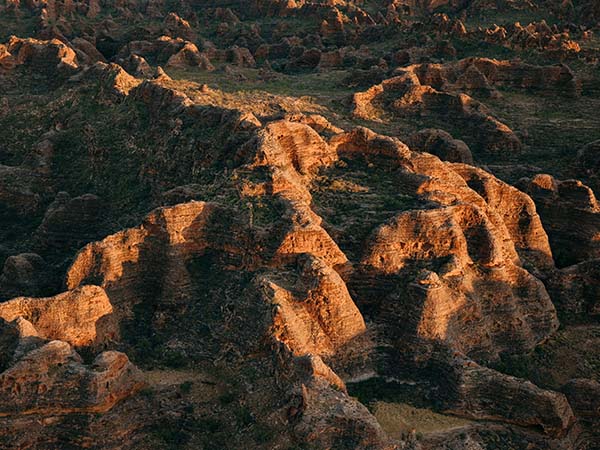
Discover the magnificent, flowing rock formations in the Bungle Bungle range. (Image: Tourism Western Australia)
660 kilometres
Words by Lara Picone
All up, there are 25 official stops dotted along the Golden Quest Discovery Trail in Western Australia, which provides a rewarding exploration of a region rich in gold rush history.
You can complete the trail at a leisurely pace over six days and start your journey at any one of the recommended stopping points. And while the self-drive adventure can be undertaken in a 2WD vehicle, a 4WD is recommended. Note: distances are route-dependent.
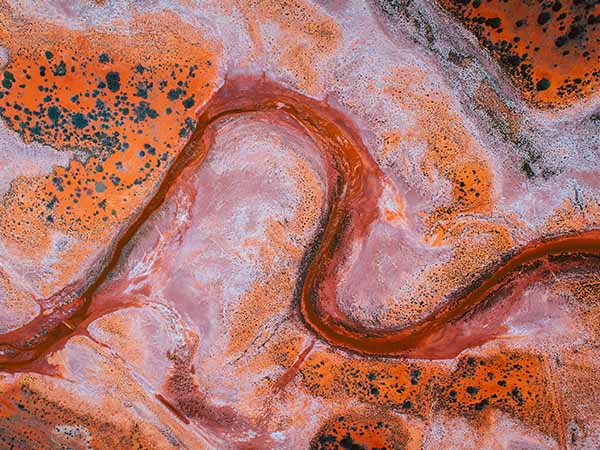
Experience the vibrant colours of the Golden Quest Discovery Trail. (Image: Tourism Western Australia)
Take up the trail in Coolgardie, seven hours’ drive east of Perth, which, in its heyday, was the unofficial capital of the Eastern Goldfields and where thousands of gold miners came to seek their fortune.
Visit the Goldfields Exhibition Museum, which has one of WA’s largest antique bottle collections before making your way to Menzies, passing the famous Golden Pipeline as well as old grave sites, ghost towns and mine shafts.
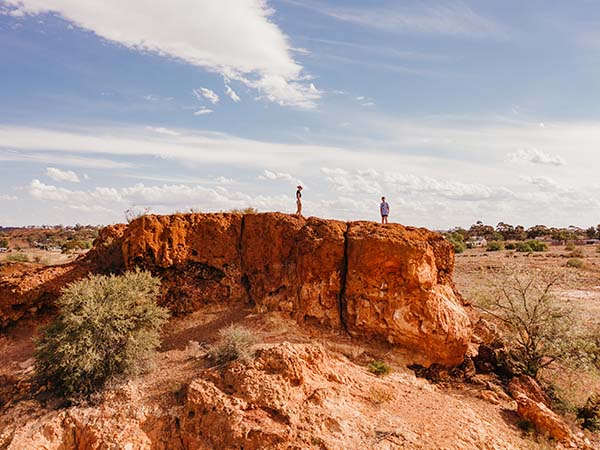
Take in the natural beauty of Coolgardie Bluff, and discover some of the fascinating iron sculptures along the track. (Image: Jared Send)
Start the day with a stroll around the tombstones of Menzies Cemetery, where tales of the town’s gold mining history are etched in stone before heading for the gold rush ghost town of Kookynie.
Enjoy a bevvie with some of the local characters (including Willie the horse) who congregate at the rustic Grand Hotel, and visit the Old Miner’s Cottage, said to be the town’s last timber and iron building still standing from the turn of the 20th century. It’s also worth the hour-long detour to Niagara Dam for a refreshing swim.
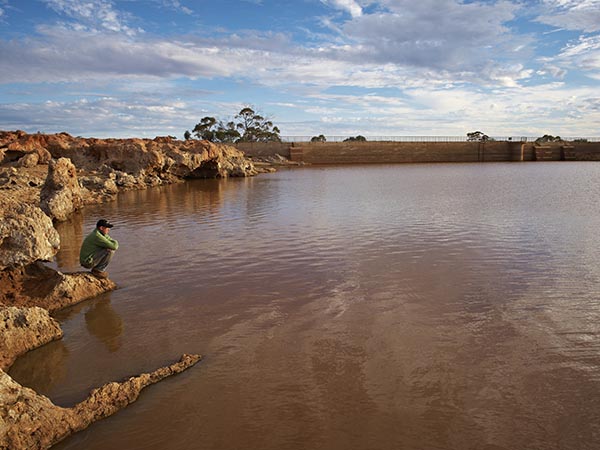
Take a break at Niagra Dam, a little Oasis in the wilderness. (Image: Tourism Western Australia)
Experience a cultural tour around Lake Ballard with Indigenous guide Linden Brownley from Bush Ghoodhu Wongutha Tours before heading to Laverton, a region that has many sites of significance to the Wongutha or Wankatja people, the Traditional Owners of the land.
Along the way you will see the abandoned township of Malcolm, pass by landscapes of flat mulga and saltbush and the lonely graves of prospectors. When in Laverton, visit the Outback Gallery, known for its Aboriginal art, and enjoy some pub grub at the Desert Inn Hotel.
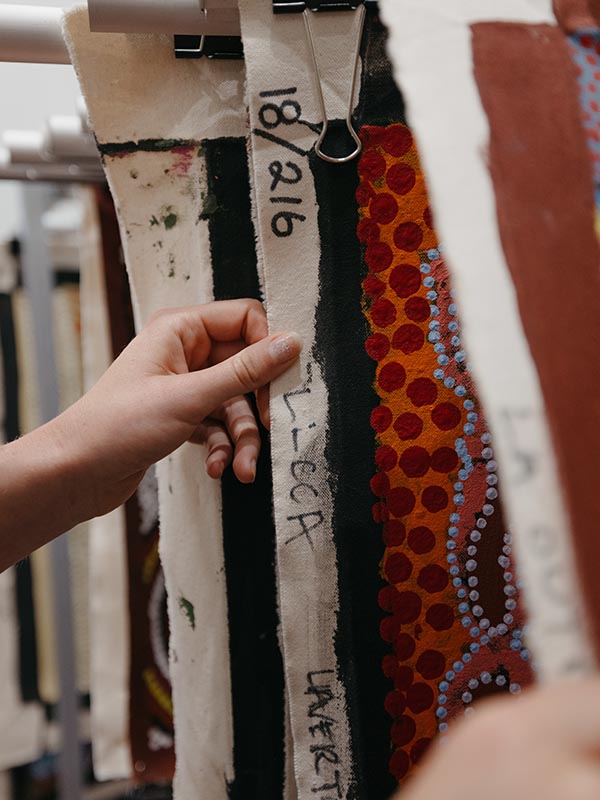
Discover the beautiful world of Indigenous Australian Art at Laverton’s Aboriginal Art Gallery. (Image Jared Send)
The landscape from Laverton to Leonora changes from the flora of the acacia woodlands to a rugged desert landscape stubbled with tufts of spinifex and groves of marble gums.
Visit the ghost town of Gwalia, which is like a time capsule from the gold-mining era, and Malcolm Dam for its bird watching and natural beauty.
Book a room at historic Hoover House designed in 1897 by young mining manager Herbert Hoover, who went on to become the 31st president of the United States.
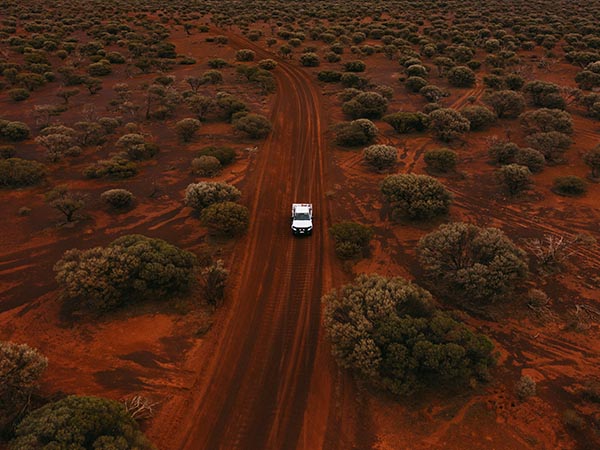
Experience the rich reds of the outback, on the way to Malcolm Dam (near Leonora). (Image: Tourism Western Australia)
Get up before dawn to make the one-hour road trip to Granite Creek where you can watch the sky bruise purple and blue around the edges.
This ancient rocky watercourse lined with river gums is a pleasant place for a breakfast picnic before heading another 50 minutes down the road to Copperfield, which was once a major mining community.
A highlight of the trail has to be Lake Ballard, where 51 metal sculptures by British artist Antony Gormley stand, dotted along the shimmering surface of the vast salt lake.
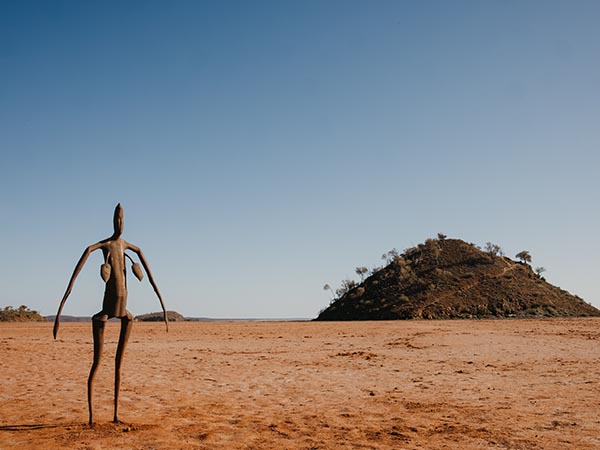
Wander around this unique art installation created by Turner Prize-winning artist Antony Gormley.
From Lake Ballard, it’s about an hour and 15 minutes to Davyhurst, another abandoned mining town inhabited by ghosts of the gold rush. It will take about two more hours to get to Broad Arrow Tavern, known for its famous Broady Burger.
It’s a further 31 kilometres to Kalgoorlie-Boulder, where you will find Australia’s only legalised two-up shed and the end of the Golden Quest Discovery Trail.
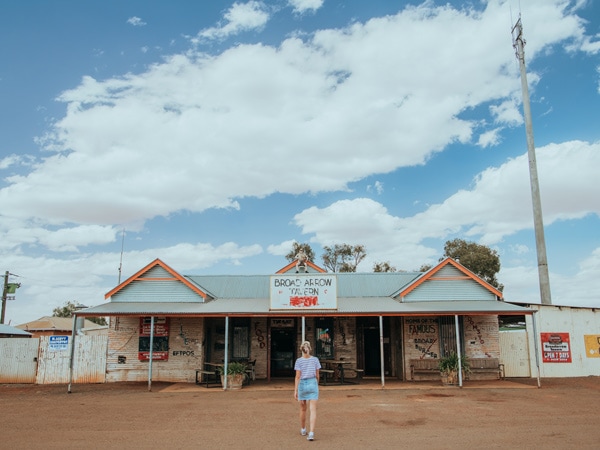
The drive to Broad Arrow Tavern in Kalgoorlie is worth it for the famous Broady Burger. (Image: Tourism Western Australia)
Words by Carla Grossetti
The geography of the Warlu Way is as photogenic as it is diverse. And steeped in culture. Discover the Dreamtime legend of the Warlu, a sea serpent said to have snaked its way through the Pilbara region of Australia’s North West, carving out the epic landscape you’ll trace along any iteration of this magical journey.
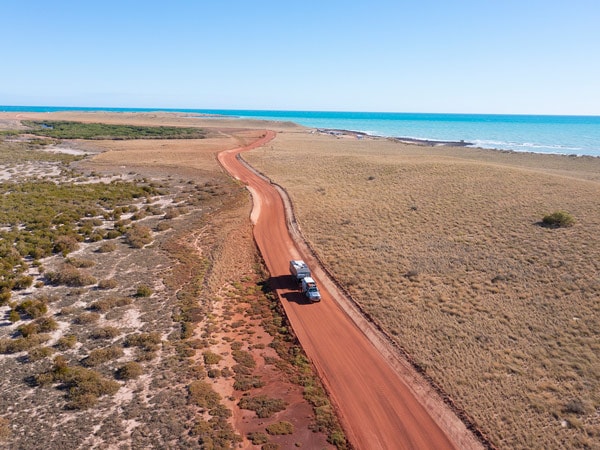
Drive the red dirt roads in Cape Keraudren, east of Port Hedland in the Pilbara. (Image: Tourism Western Australia)
Explore the ancient landscape linking Broome with Exmouth through coastal and inland sections, and along the Manuwarra Red Dog Highway and East Pilbara Geoheritage Route, where you’ll see towering rock faces, wild coastlines, stunning sunsets, plunging gorges, soaring red ranges and sapphire seas and views that stretch on forever.
Download the free Warlu Way travel app so you can choose between one of the self-drive itineraries that allow for either a return trip or a one-way adventure.
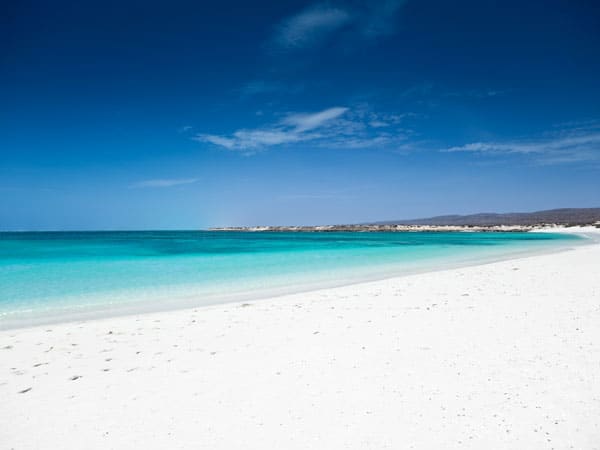
Tread the white sands of Exmouth.
You could spend an entire day sifting sand through your toes at Eighty Mile Beach or the Mackerel Islands, exploring the ancient Aboriginal rock art of the Pilbara region in Murujuga National Park (which has more than 1 million petroglyphs), or kayaking in the blue-green waters of Nhanggangunha (Deep Reach Pool), where the spirit serpent is said to live.
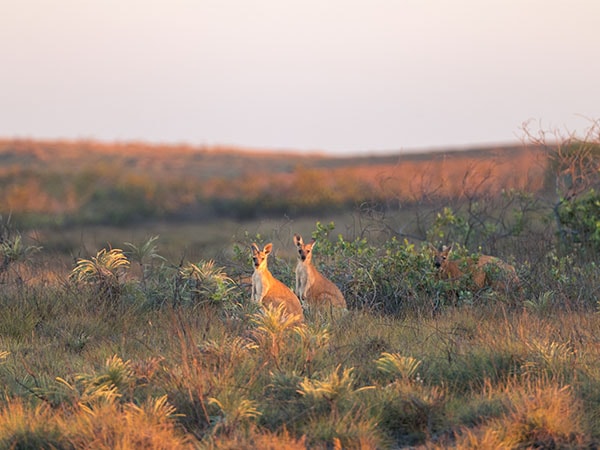
Join local wildlife to catch a vibrant sunset on the Warlu Way. (Image: CJ Maddock @cjmaddock)
Carve off to Karijini National Park to see hidden waterholes and gorges as gnarled and weathered as time amid one of the oldest landscapes on the planet.
The park lies at the heart of the Warlu Way, where the Yindjibarndi have roamed for thousands of years. Fans of the film Red Dog should detour to Dampier to snap a selfie in front of the statue dedicated to the kelpie that travelled across the Pilbara and inspired a movie of the same name.
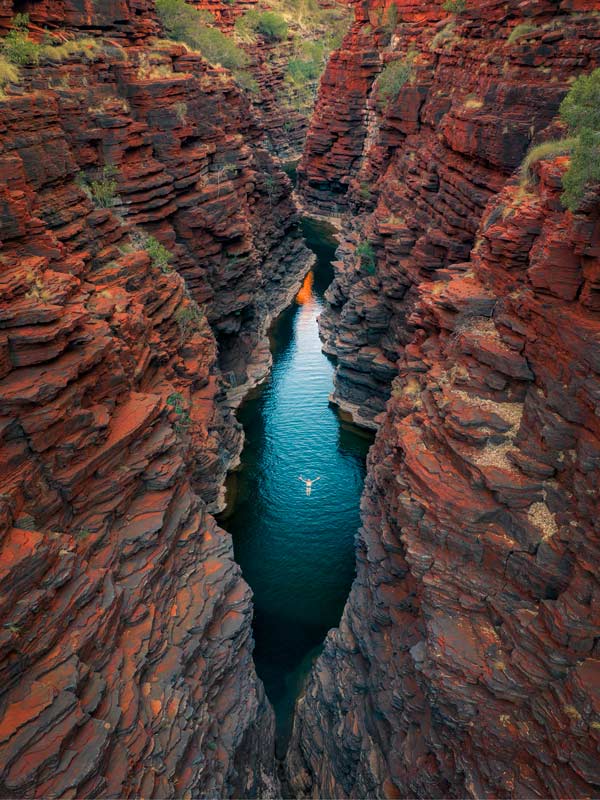
Make a stop at Joffre Gorge in Karijini National Park. Just wow. (Image: Tourism Western Australia)
The Warlu Way is almost 3000 kilometres in full and can also be explored in sections via its four interconnected routes.
Words by Carla Grossetti
The Canning Stock Route is an iconic track that extends from Halls Creek in the Kimberley region of Western Australia to Wiluna in the Mid West.
As well as being the longest historic stock route in the world, the trail offers the opportunity for an extraordinary adventure, slicing through narrow gorges, sheer cliffs, ancient Aboriginal rock art sites and engravings left by early explorers and drovers.
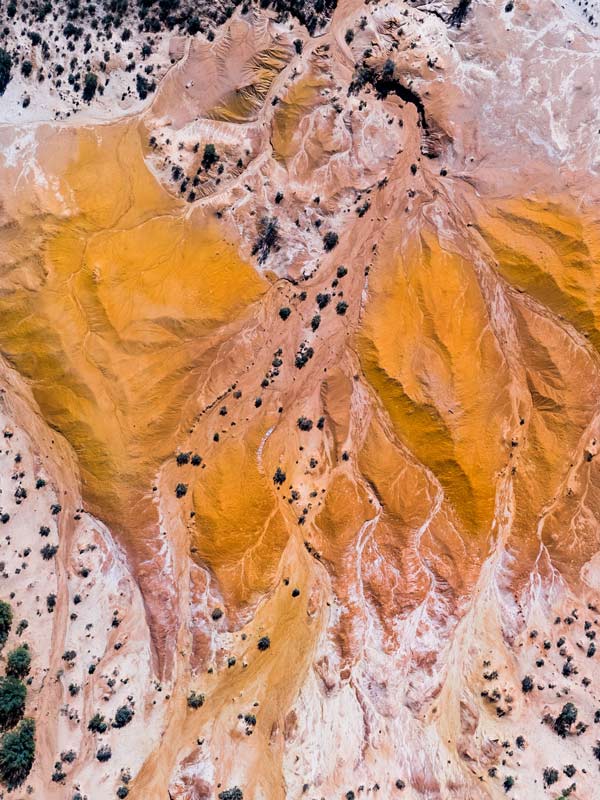
The Wolfe Creek Crater, South of Halls Creek, displays nature’s beauty. (Image: Tourism Western Australia)
Built in 1910, the route is a ragged ochre ribbon that follows in the footsteps of the East Kimberley drovers for whom the track was created. The cattlemen were looking for an alternative way to move their cattle south in order to break the West Kimberley beef monopoly.
Although you can go it alone, the most comfortable way to explore the track is with Outback Spirit, an Australian company with decades of experience guiding visitors through this raw and rugged terrain.
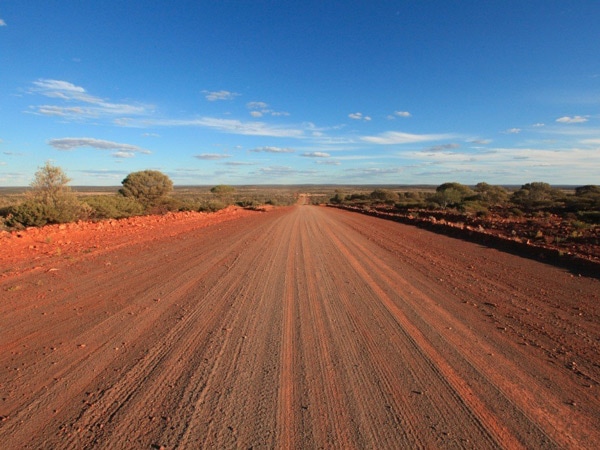
The big open road to Wiluna is as picturesque as it looks. (Image: Paul Fowler)
The stock route crosses the Gibson, Great Sandy, Little Sandy and Tanami deserts and while the cattle are now long gone, the stockmen’s history has been preserved due to the extreme isolation. The track, blessed as it is with stunning landscapes, is one of the most iconic 4WD drives in the country.
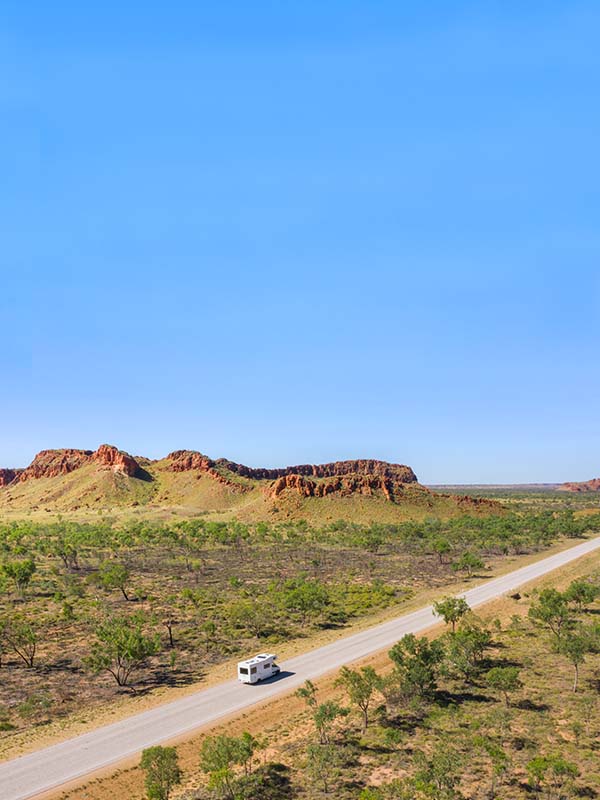
An old stock route now provides a gateway to the breathtaking scenery of the Kimberly region. (Image: Tourism Western Australia)
1850 kilometres one way.
In a desert safari tent under the stars on an Outback Spirit tour.
Words by Carla Grossetti
The Golden Pipeline is a self-guided trail that spaghettis between the Perth Hills and WA’s Eastern Goldfields.
Follow the waterway as it squiggles its way from Mundaring Weir to Mt Charlotte, and from forested hills to the red dirt of the state’s goldfields, and you will learn about the ambitious scheme to pump water higher and further than had ever been done at the end of the 19th century.
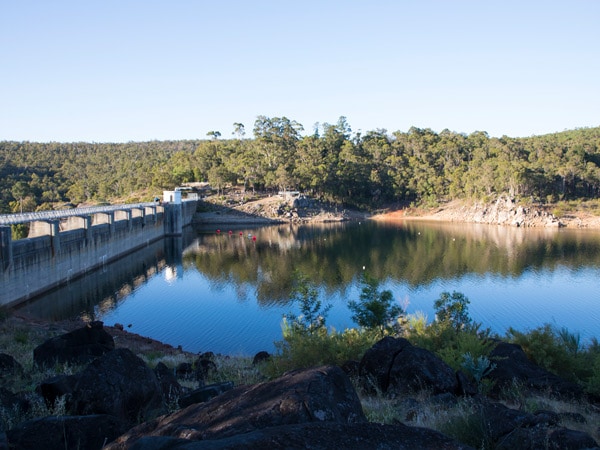
The amazing landscapes of Mundaring Weir. (Image: Tourism Western Australia)
As well as being historically significant, the Goldfields Water Supply Scheme is regarded as an engineering marvel. It has been pumping water through a steel pipeline to its destination some 560 kilometres east for more than a century, and it’s predicted it will continue to do so for another (golden) century.
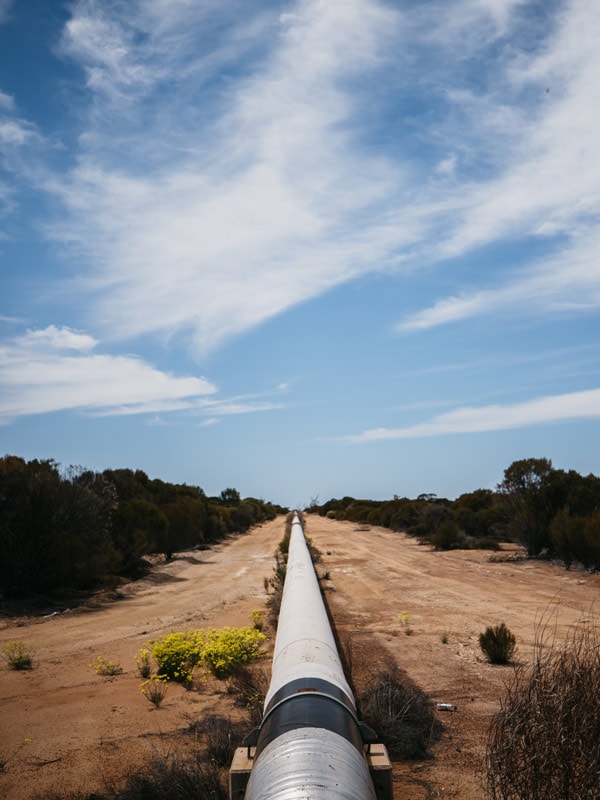
The Golden Pipeline Heritage Trail is rich in goldrush history. (Image: Tourism Western Australia)
The Golden Pipeline, a National Trust WA project, honours the work of civic engineer CY O’Connor who was responsible for creating major public works during the 1890s that stimulated the development of WA. The fact that this water supply scheme still functions effectively to this day is a testament to his skills.
The scheme came about due to the fact water was scarce in the goldfields following discovery of the precious metal in Coolgardie in 1892, then Kalgoorlie in 1893.
While some of the pump stations may be closed for remediation works, others are like open museums, standing like memorials to the great engineer.
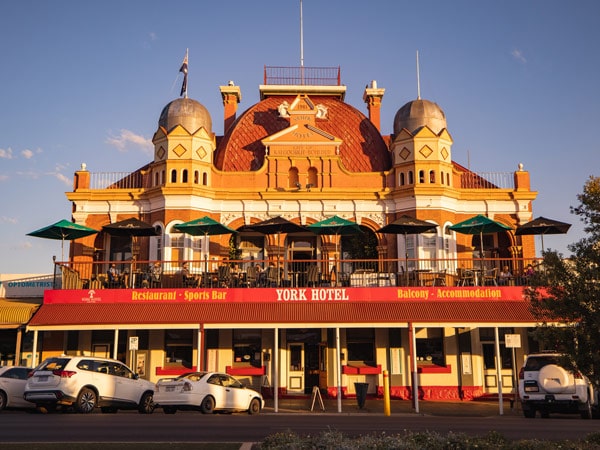
The goldfields town of Kalgoorlie is filled with mining history. (Image: Tourism Western Australia)
This is a journey into the wild, wild west. As well as learning about the water supply scheme, you can home-school your kids about WA’s gold-mining history, see dreamy sunsets and wildflowers as you make your way through the wheatbelt and the goldfields.
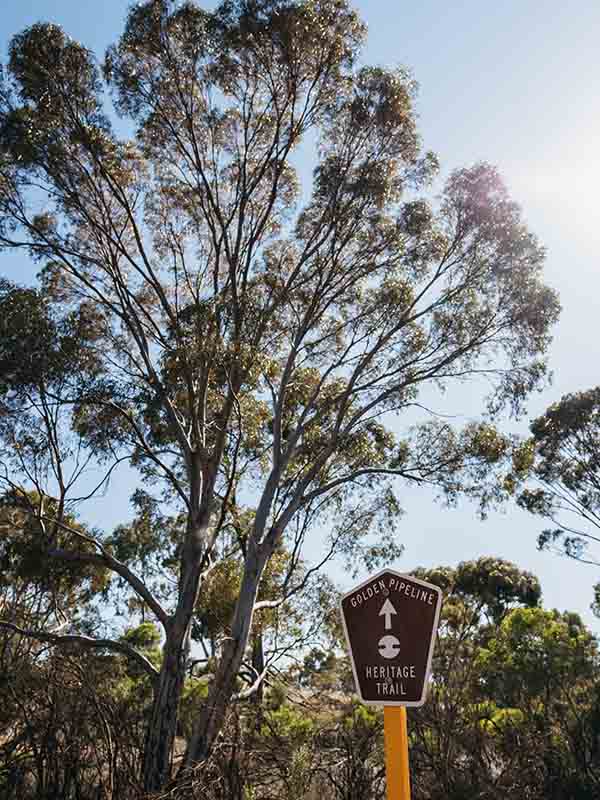
Begin a unique adventure on the Golden Pipeline Heritage Trail. (Image: Tourism Western Australia)
650 kilometres
Words by Carla Grossetti
The fastest way to drive from Margaret River to Albany is via Manjimup and the Muir Highway. But what’s the rush? Take your time and create mini diversions to enjoy along the way.
The Margaret River region is world-renowned for its food and wine, so make sure to factor in a few wineries, distilleries, microbreweries and restaurants to your itinerary.
Climb the Gloucester Tree, stretch your legs around the Big Brook Dam, go 4WDing in Yeagarup Dunes, and wander along the Valley of the Giants Tree Top Walk.
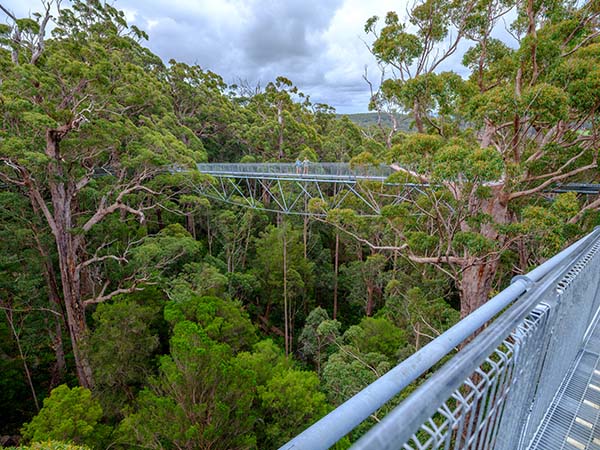
Gain a new perspective and walk among the lush canopies at the Valley of the Giants Tree Top Walk (Image: Tourism WA)
Oh and you can’t miss the Conspicuous Cliff. Literally. There are also native forests to hike around and beautiful bays and beaches that necklace the coast near Denmark. Then take the Lower Denmark Road to Albany to see some of the stunning beaches at West Cape Howe.
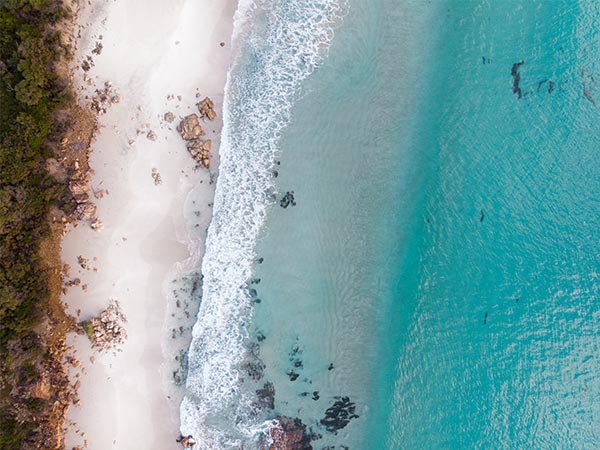
Discover the many pristine beaches scattered along the Muir Highway.
It’s 350 kilometres as the crow flies between Margaret River and Albany, which takes about four hours non-stop. You will have to factor in additional travel time to include a few of the aforementioned detours.
Break up the return drive from Albany to Perth by bunkering down for the night at the Tree Chalets in Busselton.
Words by Carla Grossetti
It’s time to get a bit funky in the Margaret River region along the Lo-Fi Wine Trail, where you will find legendary winemakers dedicated to producing low-intervention wines. Taste lesser-known varietals at the Blind Corner, Goon Tycoons and Stormflower Vineyard.
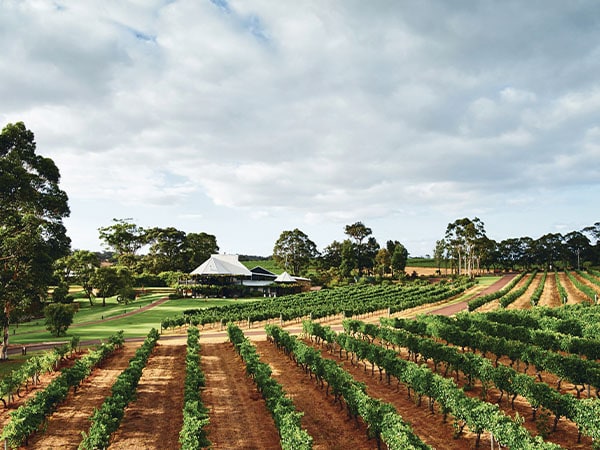
Find legendary winemakers dedicated to producing low-intervention wines. (Image: Frances Adrijich)
Intrepid oenophiles will also enjoy world-class wineries and stunning district views along the Tom Cullity Drive where Dr Tom Cullity planted the first vines at Vasse Felix in 1967. Restock your esky at the Providore Margaret River and Margaret River Chocolate Company and find a spot to set up a picnic and enjoy a spread of local ingredients. Supplement your itinerary with a few wildflower walks, hikes through national parks and swims in sheltered bays.
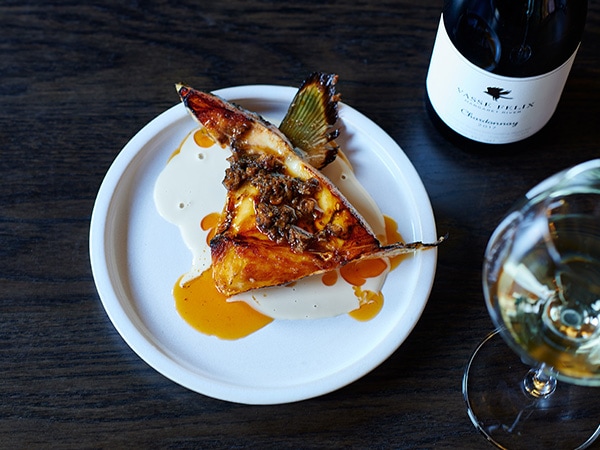
Have lunch at Vasse Felix in Margaret River. (Image: Stefan Gosatti)
The Lo-Fi Wine Trail stretches for about 20 kilometres, while Tom Cullity Drive includes eight wineries dotted along five kilometres of Margaret River’s backroads.
Words by Carla Grossetti
While the best time to visit WA for its wildflowers is between July and October, you’ll also find the landscape blanketed in blooms year-round at Lesueur National Park, Cape Range National Park and the Shark Bay World Heritage Area. Wildflower Country starts about one hour and 45 minutes north of Perth on Australia’s Coral Coast, which is home to more than 12,000 species of wildflowers.
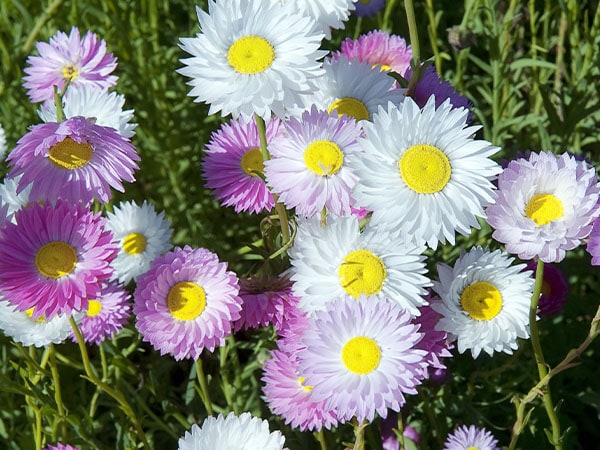
Head to Western Australia during the colourful months between July and October, when the wildflowers take-over. (Image: Australia’s Coral Coast)
Some of the prettiest fields of flowers can be found in Dandaragan, a charming farming town accessed via the Dandaragan Way, which takes you through the southern end of Wildflower Country. Download the WA Wildflower Tracker to better identify a range of blooms such as donkey orchids, spider orchids, cowslip orchids as well as clematis, sundew and Hardenbergia.
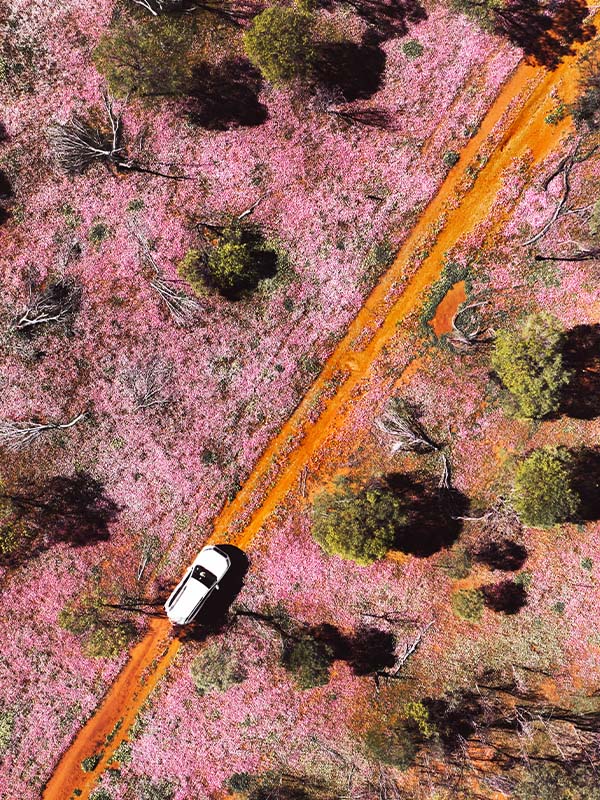
Rendezvous among magnificent wildflower blooms in Morawa, Western Australia. (Image: Tourism Western Australia)
182.5 kilometres from Perth.
Words by Carla Grossetti
The Western Australian capital of Perth is just 18 kilometres away from the Swan Valley and a hub for travellers who love good food and drinks. The growing gourmand scene is one of the hottest in the country, with great winery restaurants, craft breweries and distilleries and ample opportunities to enjoy artisan produce.
It’s an excellent day trip from Perth and a testament to the region’s bounty. Bordered by the Perth Hills, the Swan Valley is relatively flat, which means you can hire an e-bike to visit cellar doors and take your palate on an adventure. Start your feasting at Alfred’s Kitchen, which was established in a caravan after the Second World War and has expanded to a 1906 train carriage. Food-focused travellers should make time for a tasting at Olive Farm Wines, a bush tucker tour with a Noongar Elder at Mandoon Estate and a flavoursome pint of preservative-free cider at Funk Cider.
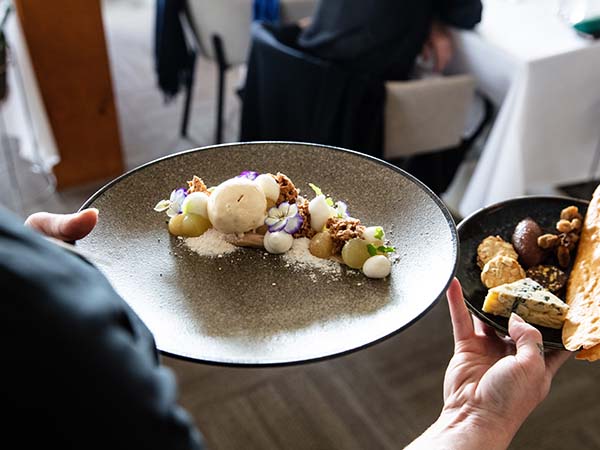
Enjoy fine dining in the elegant surrounds of Mandoon Estate. (Image: Tourism Western Australia)
You can also sample hand-crafted spirits at Old Young’s Distillery, Swan Valley Gin Company, Harris Organic Wine & Spirits, Sin Gin Distillery and Great Northern Distillery. You’ll find cool cafes such as Yahava Koffeeworks dispensing specialty coffee and the craft beer scene on show at some of the region’s charming pubs and tap rooms. You’ll also get an understanding of what local and sustainable ingredients are available at the Stirling Square Market, held on the third Sunday of every month (from February to November).
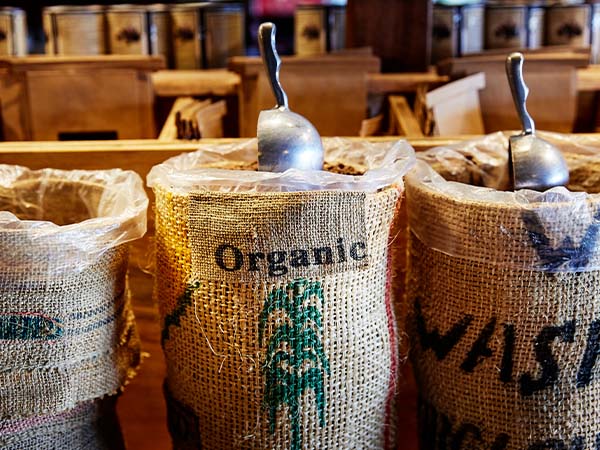
Get your coffee fix at the quaint and charming Yahava Koffeeworks. (Image: Tourism Western Australia)
18 kilometres from Perth.
Want to stretch out the day trip to an overnighter? There’s accommodation overlooking the Swan River at The Colony at Mandoon Estate.
Words by Carla Grossetti
LEAVE YOUR COMMENT